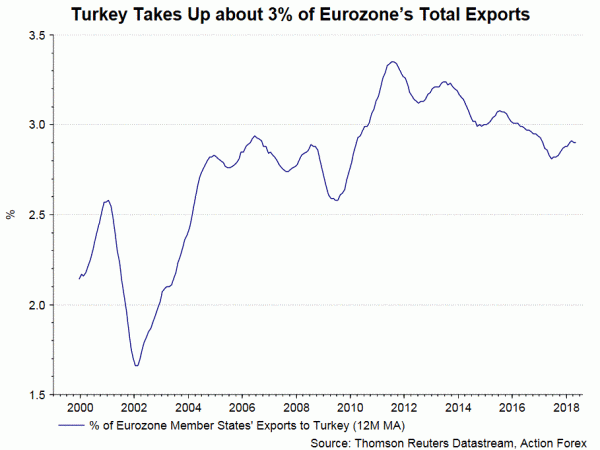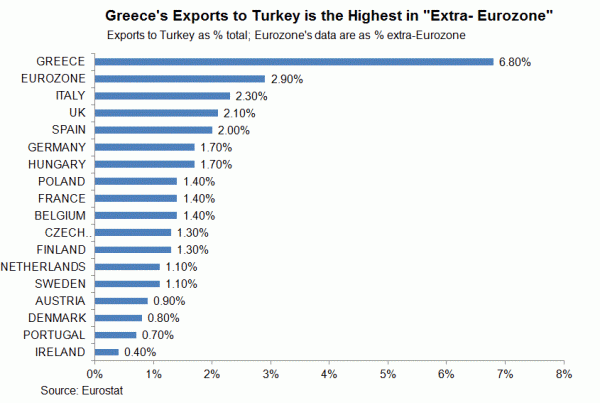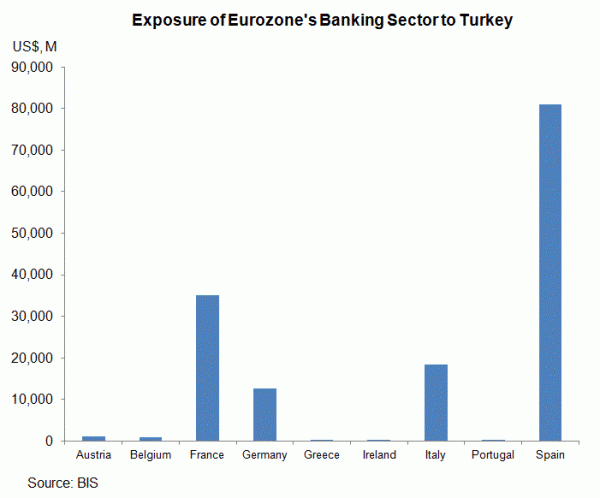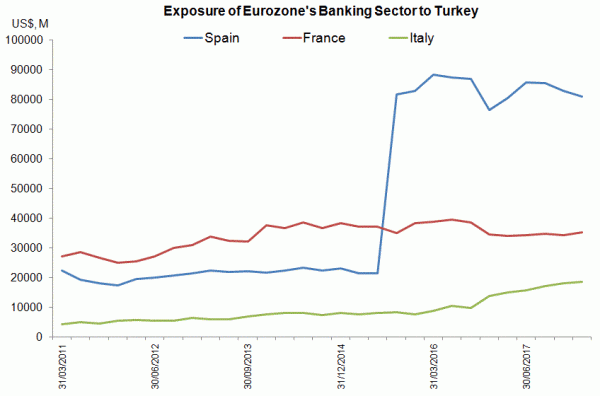Selloff in Turkish lira and euro has stabilized but the worst is not yet over. As we mentioned in the previous report, the ultimate reason for lira’s slide is President Recep Tayyip Erdogan’s failed economic and monetary policy. The Turkish central bank TCMB, since his re-election as the President, has refrained from raising interest rates despite elevated inflation. The new policy announced on Monday was nothing new. It is in line with recent monetary policy that focuses on injecting liquidity to the market by cutting reserve requirement ratios (RRR). Undeniably, US President Donald Trump’s latest sanctions have exacerbated the situation by putting the problems facing Turkey under the spotlight.
Euro’s weakness late last week was driven by a Financial Times report suggesting that ECB has become concerned about the exposure of some of Eurozone’s banks to Turkey, in particular BBVA, UniCredit and BNP Paribas. The news has sparked concerns over contagion of Turkey’s problems to other European countries, especially those in the perphery. Some have gone so far to suggest that European sovereign debt crisis in 2009/10 can return. Turkish central bank (TCMB).
We illustrate below that, the turmoil of Turkey so far has limited impacts, in terms of economy and financial system, on the Eurozone. While some peripheral economies are having closer ties to Turkey, Eurozone as a whole has limited exposure. However, evolution of the Turkish crisis should be monitored closely as market sentiment, not necessarily rational, can diminish abruptly and can spread from Turkey to other emerging markets very rapidly.
TCMB’s stimulus measures to rescue TRY
Turkish central bank announced new stimulus measures to rescue the slump in lira. It cut the reserve requirement ratios (RRR) by -250 bps for all maturity brackets and RRR for non-core FX liabilities by -400 bps or up to 3-year maturities. The maximum average maintenance facility for FX liabilities has been raised to 8%. In addition to USD, euro can be used for the maintenance against Turkish lira reserves under the reserve options mechanism. Meanwhile, approximately 10B lira, US$6B, and US$3B equivalent of gold liquidity will be provided to the financial system. We expect these measures could only provide a mild relief to the market. Indeed, injecting liquidity to the market would aggravate the soaring inflation, further constraining consumption and sustaining the economy in downward spiral.
Source: Turkish Central Bank
Turkey takes up only 3% of Eurozone exports
Considering the importance of Turkey to the Eurozone economically and financially, we believe that economic impact is limited while financial impact might be higher. Eurostat’s data shows that Turkey takes up about 3% of Eurozone’s total exports. Greece’s exposure is the highest among the member states.
Spain has most banking exposure, but just around 2.5% of aggregate balance sheet
In terms of the banking system, BIS data (https://stats.bis.org/statx/srs/table/b4?c=TR) shows that financial institutions in Spain have the most significant exposure to Turkey. This is followed by France and Italy. Note that the figures in the chart below refer to the ownership of subsidiary banks in Turkey, rather than direct loan exposure. As such, the potential loss of these financial institutions (in case of default) should be lower than the figures suggested. Spain’s exposure to Turkey is equivalent to around 2.5% of the Spanish banking sector’s aggregate balance sheet.

















